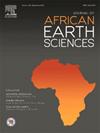埃塞俄比亚中部主裂谷Tulu Moye地热储层特征二维/三维地磁数据反演
IF 2.2
4区 地球科学
Q2 GEOSCIENCES, MULTIDISCIPLINARY
引用次数: 0
摘要
埃塞俄比亚裂谷系位于东非裂谷系的活跃区,由弱化的岩石圈、活跃的火山活动和高级的裂谷作用所定义,具有地热特征。因此,埃塞俄比亚裂谷系统是地热资源开发的有希望的地区之一,因此,在ERS中大约有120个地点拥有自己的加热和循环系统。其中7个领域已被确定为最有希望的领域。其中一个地热区是Tulu Moye地热远景区(本研究的主题),位于埃塞俄比亚中部裂谷的东部边缘。通过对地面高密度(92000点)总强度磁数据进行分析,确定了热液蚀变的存在,并绘制了地热储层的范围和几何形状。为了最大限度地减少残余磁场效应,将磁场还原到赤道(RTE),并利用结果生成2D/3D反演剖面。由RTE异常产生的许多二维磁异常模型显示了广泛的异常值(- 424至590.2 nT),用于描述地热前景。此外,还生成了3D模型来检查储层的范围和几何形状。最高的正磁异常(与RTE中强烈的岩石退磁有关,但反向描绘)集中在图鲁莫耶推断破火山口的中央部分。在中部地区,图鲁莫耶北部约100平方公里的面积被认为是主要地热储层的位置。更具体地说,Salen山以西沿Wonji断裂带从Teru Moye延伸到Giano的区域,以及Salen山以东从Gnaro延伸到Belale的区域,被认为是勘探地热井的合适位置。本文章由计算机程序翻译,如有差异,请以英文原文为准。
2D/3D inversion of geomagnetic data for characterization of the Tulu Moye geothermal reservoir, central main Ethiopian rift, Ethiopia
Owing to its location in the active parts of the East African Rift System, the Ethiopian Rift System defined by weakening lithosphere, active volcanism, and advanced levels of rifting exhibits geothermal manifestations. As a consequence, the Ethiopian Rift System is one of the promising areas for geothermal resource development and as such roughly 120 locations inside the ERS had their own heating and circulation systems. Seven of these areas have been identified as most promising. One of these geothermal areas is the Tulu Moye geothermal prospect (the subject of this study), found at the eastern margin of the Central Main Ethiopian Rift. Ground-based high density (92000 points) total intensity magnetic data were acquired and analyzed to determine the presence of hydrothermal alteration caused by thermal activity as well as map the extent and geometry of the geothermal reservoir. To minimize the remnant magnetic field effect, the magnetic field was Reduced-to-Equator (RTE) and the results were utilized to produce 2D/3D inversion sections. A number of 2D magnetic anomaly models produced from the RTE anomaly that show a wide range of anomaly values (−424 to 590.2 nT) are used to characterize the geothermal prospect. Further, 3D models were generated to examine the extent and geometry of the reservoir. The highest positive magnetic anomaly (related to strong rock demagnetization in the RTE but depicted in reverse) is focused in the central sector of Tulu Moye inferred caldera. Within the central sector, the northern portion of Tulu Moye with an approximate area of 100 km2 is presumed to be the location of the main geothermal reservoir. More specifically, an area west of Salen mount extending from Teru Moye to Giano following the Wonji Fault Belt, and an area east of Salen which extends from Gnaro to Belale are suggested to be appropriate locations for exploratory geothermal boreholes.
求助全文
通过发布文献求助,成功后即可免费获取论文全文。
去求助
来源期刊

Journal of African Earth Sciences
地学-地球科学综合
CiteScore
4.70
自引率
4.30%
发文量
240
审稿时长
12 months
期刊介绍:
The Journal of African Earth Sciences sees itself as the prime geological journal for all aspects of the Earth Sciences about the African plate. Papers dealing with peripheral areas are welcome if they demonstrate a tight link with Africa.
The Journal publishes high quality, peer-reviewed scientific papers. It is devoted primarily to research papers but short communications relating to new developments of broad interest, reviews and book reviews will also be considered. Papers must have international appeal and should present work of more regional than local significance and dealing with well identified and justified scientific questions. Specialised technical papers, analytical or exploration reports must be avoided. Papers on applied geology should preferably be linked to such core disciplines and must be addressed to a more general geoscientific audience.
 求助内容:
求助内容: 应助结果提醒方式:
应助结果提醒方式:


